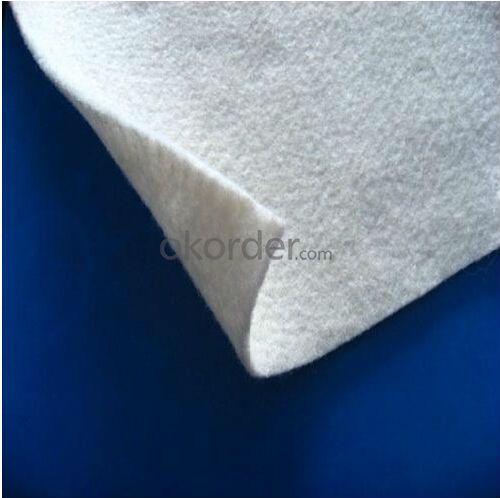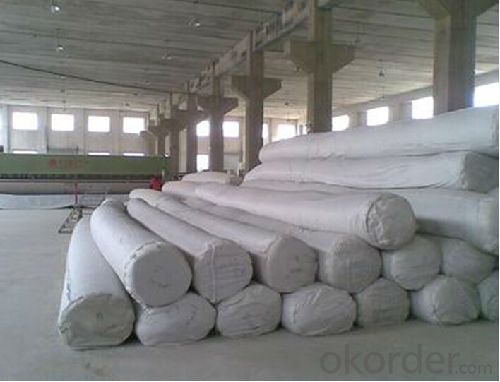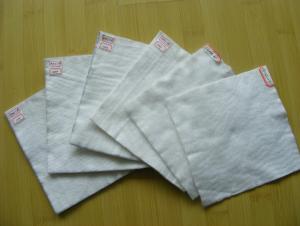PP/PET Short Fiber Needle Punched Nonwoven Geotextile with Very Competitive Price and Good Quality
- Loading Port:
- Qingdao
- Payment Terms:
- TT or LC
- Min Order Qty:
- 5000 m²
- Supply Capability:
- 120000 m²/month
OKorder Service Pledge
OKorder Financial Service
You Might Also Like
PP/PET Short Fiber Needle Punched Nonwoven Geotextile with 100g-1500g
1.Specifications of PP/PET Short Fiber Needle Punched Nonwoven Geotextile with 100g-1500g
Weight / Mass: 100g/m2-1500g/m2 .
Width: Within 8 m (1m-8m as request ).
Length: 50-200m/roll (as request).
Material: PP / PET .
Color: Black , white , grey , as your request.
Certificate: CE/ISO9001/ISO14001
Manufacturing method: nonwoven
2.Features of PP/PET Short Fiber Needle Punched Nonwoven Geotextile with 100g-1500g
Good flexibility
Permeability
Filtration
Separation and easy for construction
3.Application of PP/PET Short Fiber Needle Punched Nonwoven Geotextile with 100g-1500g
Highway
Railway
Dam
Reclamation for filtration
Separation drainage and protection
4.Technical Data of PP/PET Short Fiber Needle Punched Nonwoven Geotextile with 100g-1500g
Item | Specification | |||||||||||||||||||||||||
Weight | 100 | 150 | 200 | 250 | 300 | 350 | 400 | 450 | 500 | 600 | 800 | |||||||||||||||
Weight variation,% | -8 | -8 | -8 | -8 | -7 | -7 | -7 | -7 | -6 | -6 | -6 | |||||||||||||||
Thickness(mm≥) | 0.9 | 1.3 | 1.7 | 2.1 | 2.4 | 2.7 | 3.0 | 3.3 | 3.6 | 4.1 | 5.0 | |||||||||||||||
Width variation,% | -0.5 | |||||||||||||||||||||||||
Break strength ,KN/m≥ | 2.5 | 4.5 | 6.5 | 8.0 | 9.5 | 11.0 | 12.5 | 14.0 | 16.0 | 19.0 | 25.0 | |||||||||||||||
Elongation at break,% | 25-100 | |||||||||||||||||||||||||
CBR Mullen Burst Strength | 0.3 | 0.6 | 0.9 | 1.2 | 1.5 | 1.8 | 2.1 | 2.4 | 2.7 | 3.2 | 4.0 | |||||||||||||||
Sieve size O90(O95),mm | 0.07-0.2 | |||||||||||||||||||||||||
Vertical Permeability Coefficient cm/s | K×(10-1-10-3) | |||||||||||||||||||||||||
Tear strength,KN≥ | 0.08 | 0.12 | 0.16 | 0.2 | 0.24 | 0.28 | 0.33 | 0.38 | 0.42 | 0.46 | 0.6 | |||||||||||||||
5.Some Photos of PP/PET Short Fiber Needle Punched Nonwoven Geotextile with 100g-1500g


- Q:Why lay the geotextile cloth after the gravel cushion
- To prevent the upper and lower gravel, soil and concrete mixed between.
- Q:Can geotextiles be used in road shoulder stabilization?
- Yes, geotextiles can be used in road shoulder stabilization. Geotextiles are often used to reinforce and stabilize road shoulders by providing separation, filtration, and reinforcement functions. They help prevent erosion and improve the strength and stability of the road shoulder, making it suitable for various types of traffic loads.
- Q:Can geotextiles be used in railway track bed stabilization?
- Yes, geotextiles can be used in railway track bed stabilization. Geotextiles are often used as a separation layer between the subgrade and ballast in railway track construction. They help to prevent the mixing of fine subgrade soils with the ballast, improving overall stability and drainage of the track bed. Geotextiles also provide reinforcement and enhance the load-bearing capacity of the track bed, reducing settlement and extending the lifespan of the railway infrastructure.
- Q:You produce 700 grams of high-strength polypropylene geotextile it?
- 700 grams of high-strength polypropylene geotextile is designed for high-speed rail sliding layer of high-strength wear-resistant geotextile, our products in the West high-speed rail passenger line, OKorder and Hangzhou and other high-speed rail lines have applications.
- Q:Where to find the right geotextile
- Geotextile types are many, according to the manufacturing process of spinning, woven, woven, according to the material is divided into filaments, short wire and so on, if the most suitable geotextile should be the project requirements are not very strict , Generally like building coverage, road maintenance, etc., like this price is generally around 0.5 angle
- Q:How do geotextiles help with erosion control on slopes?
- Geotextiles help with erosion control on slopes by providing a physical barrier that stabilizes the soil and prevents erosion. These synthetic fabrics are placed on the slope surface to act as a filter, allowing water to pass through while retaining soil particles. This helps to reduce the velocity of runoff, prevent soil erosion, and promote the growth of vegetation.
- Q:What are the key differences between woven and nonwoven geotextiles?
- The key differences between woven and nonwoven geotextiles lie in their manufacturing processes and physical characteristics. Woven geotextiles are made by interlacing yarns or fibers together to create a stable and strong fabric. On the other hand, nonwoven geotextiles are produced by bonding or felting fibers together without any weaving process. In terms of physical characteristics, woven geotextiles generally have higher tensile strength and puncture resistance due to their interlaced structure. They also offer better filtration properties as the open spaces between the woven yarns allow for effective water flow. Nonwoven geotextiles, however, have a higher permittivity, meaning they have a greater ability to allow water to pass through. Another notable difference is their durability. Woven geotextiles tend to be more resistant to UV degradation and offer better long-term performance, making them suitable for applications that require high strength and stability over time. Nonwoven geotextiles, although less durable, are often used for short-term projects or where filtration and separation are the main requirements. Overall, the choice between woven and nonwoven geotextiles depends on the specific application and desired properties. Woven geotextiles are typically favored for their strength and longevity, while nonwoven geotextiles are preferred for their filtration capabilities and cost-effectiveness in certain applications.
- Q:What are the key considerations for geotextile installation in areas prone to landslides?
- The key considerations for geotextile installation in areas prone to landslides include: 1. Site evaluation: Conduct a thorough assessment of the site to understand the slope stability, soil conditions, and potential triggers for landslides. This will help determine the appropriate type and strength of geotextile needed. 2. Design and engineering: Engage geotechnical engineers to design a tailored solution based on the specific needs of the site. They will consider factors such as slope gradient, soil type, and expected loads to determine the appropriate geotextile specifications. 3. Drainage management: Proper drainage is critical to prevent water accumulation, which can increase the risk of landslides. Geotextiles can be used to enhance drainage by allowing water to pass through while retaining soil particles. 4. Anchoring and securing: Geotextiles should be securely anchored to the slope to ensure stability. This may involve using appropriate anchor systems or integrating the geotextile into the existing slope or retaining structure. 5. Monitoring and maintenance: Regular monitoring is essential to identify any signs of distress or movement in the slope. Timely maintenance and repair of the geotextile system can help prevent potential failures and ensure its long-term effectiveness in landslide-prone areas.
- Q:How do geotextiles help with groundwater protection?
- Geotextiles help with groundwater protection by acting as a barrier that prevents the movement of contaminants and pollutants from entering the groundwater. They are designed to filter and separate soil particles, allowing water to pass through while trapping harmful substances. Additionally, geotextiles can also enhance the stability and permeability of soil, reducing the risk of erosion and promoting proper drainage, which further aids in protecting the quality and quantity of groundwater.
- Q:Composite geotextile 20-500-0.5 what it means
- 0.5 should be the film thickness of 20-500. Did not understand the estimated cloth is the bar, not like
1. Manufacturer Overview |
|
|---|---|
| Location | 示范:Hebei, China |
| Year Established | 示范:1997 |
| Annual Output Value | 示范:Above US$50 Million |
| Main Markets | 30.00% South America; 20.00% North America; 15.00% Eastern Europe; 15.00% Southeast Asia; 10.00% South Asia; 5.00% Southern Europe; 5.00% Africa |
| Company Certifications | ISO 9001:2008 |
2. Manufacturer Certificates |
|
|---|---|
| a) Certification Name | |
| Range | |
| Reference | |
| Validity Period | |
3. Manufacturer Capability |
|
|---|---|
| a)Trade Capacity | |
| Nearest Port | Tianjin;Qingdao;Shanghai |
| Export Percentage | |
| No.of Employees in Trade Department | 21-50 People |
| Language Spoken: | English;Chinese |
| b)Factory Information | |
| Factory Size: | Above 100,000 square meters |
| No. of Production Lines | Above 12 |
| Contract Manufacturing | OEM Service Offered;Design Service Offered |
| Product Price Range | High;Average |
Send your message to us
PP/PET Short Fiber Needle Punched Nonwoven Geotextile with Very Competitive Price and Good Quality
- Loading Port:
- Qingdao
- Payment Terms:
- TT or LC
- Min Order Qty:
- 5000 m²
- Supply Capability:
- 120000 m²/month
OKorder Service Pledge
OKorder Financial Service
Similar products
New products
Hot products
Hot Searches
Related keywords

































